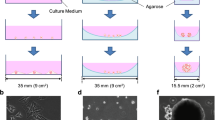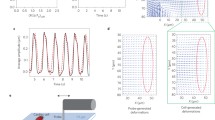Summary
When two spontaneously beating neonatal rat heart cells in tissue culture were allowed to grow together they synchronized their originally independent beats to a common rhythm, as measured with an opto-electronic technique. Both single isolated cells and cell pairs exhibited a highly irregular beating pattern. Beating irregularity was strongly and positively correlated with mean interbeat interval. Synchronization of beating occurred in 50% of the pairs studied within one beating interval. In the remaining cell pairs, the first synchronized beat was followed by a 4–65 s period of partial synchronization. The time difference between contraction moments of two cells in a pair respective to each other (latency) changed upon synchronization from a random value to a fixed value. In a few cases the latency decreased during 20 to 30 s after the first synchronized beat before a steady-state value was reached. The mean interbeat interval (IBI) of the synchronized cell pairs was governed by the mean IBI of the originally faster beating cel. In 83% of the cases the mean IBI of the cell pairs was between that of the originally isolated beating cells. We conclude from the experiments described that physical coupling (i.e. gap junction formation) is virtually complete before beating synchronization occurs.
Similar content being viewed by others
References
Barr L, Dewey MM, Berger W (1965) Propagation of action potentials and the structure of the nexus in cardiac muscle. J Physiol 48:797–823
Blondel B, Royen I, Cheneval JP (1971) Heart cells in culture: a simple method to increase the proportion of myoblasts. Experientia 27:356–358
Clapham DE, Shrier A, DeHaan RL (1980) Junctional resistance and action potential delay between embryonic heart cell aggregates. J Gen Physiol 75:633–654
Clay JR, DeHaan RL (1979) Fluctuations in interbeat interval in rhythmic heart cell clusters. Biophys J 28:377–390
Clay JR, DeFelice LJ, DeHaan RL (1979) Current noise parameters derived from voltage noise and impedance in embryonic heart cell aggregates. Biophys J 28:169–184
De Bruijne J, Jongsma HJ (1980) Membrane properties of aggregates of collagenase dissociated rat heart cells. In: Tajuddin M, Das PK, Tariq M, Dhalla NS (eds) Advances in myocardiology. University Park Press, Baltimore, vol 1, pp 231–243
De Mello WC (1982) Cell-to-cell communication in heart and other tissues. Prog Biophys Molec Biol 39:147–182
DeHaan RL (1982) In vitro models of entrainment of cardiac cells. In: Bouman LN, Jongsma HJ (eds) Cardiac rate and rhythm. Martinus Nijhoff, Den Haag, pp 323–361
DeHaan RL, Hirakow R (1972) Synchronization of pulsation rates in isolated cardiac myocytes. Exper Cell Res 70:214–220
Herzberg EL, Spray DC, Bennett MVL (1985) Reduction of gap junctional conductance by microinjection of antibodies against the 27 kDa liver gap junction polypeptide. Proc Nat Acad Sci USA 82:2412–2416
Jalife J, Antzelevitch C (1979) Phase resetting and annihilation of pacemaker activity in cardiac tissue. Science 206:695–697
Jongsma HJ, Tsjernina L (1982) Factors influencing regularity and synchronization of beating of tissue cultured heart cells. In: Bouman LN, Jongsma HJ (eds) Cardiac rate and rhythm. Martinus Nijhoff, Den Haag, pp 397–414
Jongsma HJ, Van Rijn HE (1972) Electrotonic spread of current in monolayer cultures of neonatal rat heart cells. J Membr Biol 9:341–360
Jongsma HJ, Masson-Pévet M, Hollander CC, De Bruijne J (1975) Synchronization of the beating frequency of cultured rat heart cells. In: Lieberman M, Sano T (eds) Developmental and physiological correlates of cardiac muscle. Raven Press, New York, pp 185–196
Jongsma HJ, Masson-Pévet MA, Tsjernina L (1983) The development of coupling between beating heart cells in tissue culture. J Physiol 334:59P
Jongsma HJ, Tsjernina L, De Bruijne J (1983) The establishment of regular beating in populations of pacemaker heart cells. A study with tissue cultured rat heart cells. J Mol Cell Cardiol 15:123–133
Jongsma HJ, Van Ginneken ACG, Van Meerwijk WPM (1984) The membrane potential of single isolated heart cells. Biophys J 45:53a
Jongsma HJ, Masson-Pévet MA, Rook M (1985) Synchronization behaviour of rat heart cell pairs in tissue culture. J Physiol 366:87P
Joyner RW, Picone J, Veenstra R, Rawling D (1983) Propagation through electrically coupled cells. Effects of regional changes in membrane properties. Circ Res 53:526–534
Loewenstein WR, Kanno Y, Soccolar SJ (1978) Quantum jumps of conductance during formation of membrane channels at the cell-cell junction. Nature 274:133–136
Metzger P, Weingart R (1985) Electric current flow in cell pairs isolated from adult rat hearts. J Physiol 366:177–195
Page E, Shibata Y (1981) Permeable junctions between cardiac cells. Ann Rev Physiol 43:431–441
Spray DC, Bennett MVL (1985) Physiology and pharmacology of gap junctions. Ann Rev Physiol 47:281–303
Van Meerwijk WPM, De Bruin G, Van Ginneken ACG, Van Hartevelt J, Jongsma HJ, Kruyt EW, Scott SS, Ypey DL (1984) Phase resetting properties of cardiac pacemaker cells. J Gen Physiol 83:613–629
Weidmann S (1966) The diffusion of radio potassium across intercalated disks of mammalian cardiac muscle. J Physiol 187:323–342
Weingart R (1986) Electrical properties of the nexal membrane studied in rat ventricular cell pairs. J Physiol 370:267–284
White RL, Spray DC, Schwartz GJ, Wittenberg BA, Bennett MVL (1985) Some electrical and pharmacological properties of gap junctions between adult ventricular myocytes. Am J Physiol 249:C447-C455
Woodbury JW, Crill WE (1961) On the problem of impulsc conduction in the atrium. In: Florey E (ed) Nervous inhibition. Pergamon Press, Oxford, pp 124–135
Ypey DL, Clapham DE, DeHaan RL (1979) Development of electrical coupling and action potential synchrony between paired aggregates of embryonic heart cells. J Membr Biol 51:75–96
Ypey DL, Van Meerwijk WPM, DeHaan RL (1982) Synchronization of cardiac pacemaker cells by electrical coupling. In: Bouman LN, Jongsma HJ (eds) Cardiac rate and rhythm Martinus Nijhoff, Den Haag, pp 363–395
Author information
Authors and Affiliations
Additional information
Dr. Masson-Pévet is presently at the CNRS (J. E. 033669) Strasbourg, France.
Rights and permissions
About this article
Cite this article
Jongsma, H.J., Masson-Pévet, M. & Tsjernina, L. The development of beat-rate synchronization of rat myocyte pairs in cell culture. Basic Res Cardiol 82, 454–464 (1987). https://doi.org/10.1007/BF01907093
Received:
Issue Date:
DOI: https://doi.org/10.1007/BF01907093




